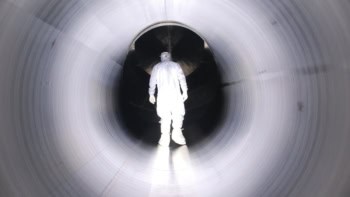Flash Physics is our daily pick of the latest need-to-know developments from the global physics community selected by Physics World‘s team of editors and reporters

Skyrmions veer off unexpectedly
An unexpected property of skyrmions has been discovered by physicists in Germany and the US. Skyrmions are particle-like regions within a field where all of the field vectors point either towards or away from a single point. They were originally proposed in the 1950s by British physicist Tony Skyrme to explain aspects of particle physics. Researchers have since discovered that some collective excitations of electron spins in solids behave much like skyrmions. These are “topologically stable”, which means that skyrmions are difficult to destroy. This makes them very attractive for use in “racetrack memories” in which data could be encoded in skyrmions that are then moved along a track using electrical currents. Now, Kai Litzius and colleagues at the Johannes Gutenberg University in Mainz and the Massachusetts Institute of Technology have shown that skyrmions can be reliably moved along a racetrack made of layered thin films. Using time-resolved X-ray microscopy, they were also able to measure the “skyrmion Hall angle” between the direction of the electrical current and the motion of the skyrmions. They were surprised to find that the angle depended upon the velocity of the skyrmions – something that had not been expected. Writing in Nature Physics, the physicists speculate that the unexpected property could be caused by the deformation of skyrmions.
Antineutrino detector could monitor nuclear fuel
An antineutrino detector could be used to monitor what type of fuel is being used in a nuclear reactor, according to Patrick Jaffke and Patrick Huber at Virginia Tech in the US. They say that this could be used to confirm that nuclear-weapons material is being destroyed in a reactor. Nuclear fission produces copious numbers of antineutrinos and several reactors worldwide are used as sources for neutrino-physics experiments. It turns out that different nuclides – such as isotopes of uranium and plutonium – produce antineutrinos at different energies, so the composition of nuclear fuel could be determined by measuring the energy spectrum of emitted antineutrinos. However, making such measurements has been impractical because antineutrinos interact very rarely with matter and therefore a huge and expensive detector would be required. Now, Jaffke and Huber have calculated that a relatively small neutrino detector weighing in at just five tonnes could monitor a reactor if it is placed 25 m from the core and takes measurements over several 90 day periods. In a preprint on arXiv, the pair argue that such a detector could differentiate between four major reactor fuels at a statistical certainty of 95%. They also say that the system can differentiate between the burning of mixed-oxide (MOX) fuel with high levels of plutonium and normal MOX fuel. This could be used to verify that plutonium – which could be used in nuclear weapons – is being destroyed.
Dark-matter pioneer Vera Rubin dies at 88
The US astronomer Vera Rubin, who presented convincing evidence of the existence of dark matter, has died at the age of 88. Born in Philadelphia, Pennsylvania, Rubin completed a degree in astronomy at Vassar College in New York state before studying for a masters degree in physics at Cornell University. After graduating in 1951, she then headed to Georgetown University in Washington DC to carry out a PhD in astronomy, which she completed in 1954. After working at the university until 1962, Rubin moved to the Carnegie Institute of Washington, where she remained for the rest of her career. While working with the astronomer Kent Ford in the 1970s, the pair studied the rotation curves of galaxies and uncovered a discrepancy between the predicted angular motion of galaxies and the observed motion, predicting that a huge amount of unseen mass – known as dark matter – must be holding them together.
Sidney Drell: 1926–2016
Sidney Drell, a former deputy director of the Stanford Linear Accelerator Center (SLAC) in the US, has died at the age of 90. Born in Atlantic City, New Jersey, Drell graduated with a degree in physics from Princeton University in 1946 before receiving a PhD from the University of Illinois, Urbana-Champaign, in 1949. After a stint teaching physics at Stanford University in 1950, he headed to the Massachusetts Institute of Technology before returning to Stanford in 1956. From 1969 until he retired in 1998, Drell served as deputy director of SLAC, which is now called the SLAC National Accelerator Laboratory. Apart from making major contributions to quantum electrodynamics and high-energy particle physics, Drell was also an expert in nuclear-arms control and cofounded the Center for International Security and Arms Control (now the Center for International Security and Cooperation). Drell was also an original member of JASON, a group of academic scientists that advises the government on national security and defence issues.
Fermilab pioneer Ned Goldwasser dies at 97
Ned Goldwasser, who was the first deputy director of Fermilab, has died at the age of 97. Beginning in 1967, Goldwasser oversaw the construction of the National Accelerator Laboratory (renamed Fermilab in 1974) near Chicago, scheduled its experimental programme, and managed its Program Advisory Committee. Working with director Robert Wilson, he also created and implemented Fermilab’s pioneering employment equality programme. Goldwasser stepped down as deputy director in 1978 and returned to his academic career at the University of Illinois. He also worked on the cancelled Superconducting Super Collider project as well as the LIGO gravitational-wave collaboration. Goldwasser attended Harvard University before serving in the US Navy. He received his PhD in physics from the University of California, Berkeley and joined the University of Illinois in 1951.
- You can find all our daily Flash Physics posts in the website’s news section, as well as on Twitter and Facebook using #FlashPhysics.



